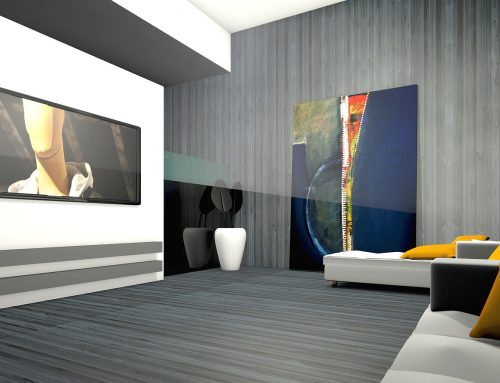Kennen Sie schon die populärsten 3D Rendering Software-Lösungen auf dem Markt.
3D Rendering Software hat in den letzten 10 Jahren sehr große Fortschritte gemacht. Architekten und Designer sind immer stärker auf lebensechte Renderings ihrer Arbeiten angewiesen. Zum Glück benötigt man aufgrund der vorhandenen 3D Renderings Software dafür heute keine Serverfarm und auch keinen Master-Abschluss in Informatik mehr.
Heutzutage gibt es zahlreiche gute 3D Rendering Software und Plug-ins, so dass die Auswahl nicht immer einfach ist. Die meisten Anwender bleiben bei der Software, mit der Sie anfangs begonnen hatten.
Wenn Sie jedoch Anfänger sind und ihr Repertoire an Softwarekenntnissen erweitern möchten, sollten Sie sich über die gängige 3D Software ausführlich informieren. Die folgende Sammlung von 3D Rendering Software deckt nicht alles ab, was aktuell auf dem Markt verfügbar ist, aber Sie repräsentiert die beliebtesten Programme, die von Architekten, Künstlern und Designern aktuell verwendet werden.
VRay ist die Creme a la Creme im 3D-Bereich und ist in den letzten 5 Jahren an die Spitze der Visualisierungssoftware aufgestiegen. VRay wurde von der Chaos Group entwickelt und ist bekannt für seine riesige Bibliothek an Texturen und den unübertroffenen Realismus. Wenn Sie Designer sind und einen höchstmöglichen Realismus bei Farben, Licht und Schatten nachbilden möchten, dann liegen Sie mit VRay goldrichtig.
Aufgrund der großen Anzahl verschiedener Funktionen und der hohen Flexibilität kann VRay für Anfänger schon recht kompliziert werden. Allerdings finden sich online zahlreiche Tutorials und Lerneinheiten, so dass Einsteiger schnell Hilfe bei entstehenden Problemen bekommen können. Das Kernstück von VRay sind die Light- und Shadowfunktionen.
VRay als PlugIn ist kompatibel mit u.a. 3ds Max, Cinema 4D, Google Sketchup, Autodesk Revit etc. Damit eignet sich VRay hervorragend für Designer, die häufig zwischen verschiedenen Software-Lösungen wechseln.
Mental Ray.
Mental Ray ist wahrscheinlich die einzigste Render-Engine in dieser Liste, die den Vergleich mit VRay nicht scheuen muss. Die Auswahlentscheidung zwischen VRay und Mental Ray basiert häufig aufgrund von persönlichen Vorlieben und Markentreue. Mental Ray ist ein wenig benutzerfreundlicher als VRay, erreicht dafür aber nicht das Niveau und die Qualität des Realismus, zu dem VRay fähig ist. Insgesamt gesehen ist Mental Ray ein hervorragendes Produkt, welches seine Reputation als exzellenter Renderer absolut verdient.
Mental Images wurde von Mental Ray im Jahre 2007 entwickelt, um eine universelle Rendering-Engine zu entwickeln, die von einer Vielzahl von Designern und Künstlern genutzt werden kann. Aufgrund der Benutzerfreundlichkeit und Vielseitigkeit ist Mental Images hervorragend für Architekten geeignet. Für Anfänger eignet sich Mental Ray besser als VRay. Sie werden staunen, wozu Mental Ray in den richtigen Händen in der Lage ist.
Viele beschweren sich, dass Maxwell langsam ist. Aber wenn Sie ausreichend Zeit haben, können Sie mit Maxwell nicht viel falsch machen. Viele Anwender bevorzugen Maxwell und die Ursache dafür scheint klar zu sein. Maxwell verwendet eine einzigartige Lighting-Engine, die als Unbiased Rendering bezeichnet wird, welche reale Modellierungstechniken anstelle von Tricks und Shortcuts verwendet, die andere Renderer verwenden. Der Kompromiss für realistisches Licht sind die langen Renderzeiten, welche sich aus komplexen, hochauflösenden Bildern ergeben können.
Eine hilfreiche Ergänzung zur Visualisierungssoftware ist Maxwell Fire: eine blitzschnelle Engine, die es ihnen ermöglicht, eine körnige Version des Renderings zu sehen, welche Sie gerade erstellen. Dieses niedrigauflösende Bild prognostiziert Licht, Farbe und Materialität ohne Wartezeit. Dies ist eine großartige Ergänzung für Architekten und Designer. Anwender erhalten bereits im Vorfeld eine Präsentation, ohne kostbare Stunden damit zu verbringen, auf die Plackerei eines Renderings in Druckqualität warten zu müssen.
Cinema 4D.
Cinema 4D ist nicht nur 3D Modellierungssoftware und nicht nur ein einfacher Renderer. Cinema 4D ist das Gesamtpaket, welches Anwendern die Möglichkeit gibt, sowohl 3D-Modelle als auch 3D-Rendering-Funktionen in vorzeigbarer Präsentationsqualität im gleichen Paket zu nutzen. Bauen, Modellieren, Texturieren, Animieren und Rendern. Mit Cinema 4D ist nahezu alles möglich und es lassen sich beeindruckende Kreationen erstellen. Allerdings sollten Sie bei der Einarbeitung in Cinema 4D viel Zeit miteinplanen.
Und wenn Sie einer der aufmüpfigen Architekten sind, die z.B. auf AutoCAD schwören, sollten Sie Cinema 4D ganz oben auf ihrer Liste der Add-ons platzieren, weil die Programme nahtlos zusammenarbeiten können.
Modo.
Trotz des weniger bekannten Namens ist Modo wohl für Architekten am besten geeignet. Wie Cinema 4D ist auch Modo ein All-in-One 3D-Modellierer, welcher mit einer leistungsstarken Rendering-Engine ausgestattet ist. Modo zeichnet sich durch die Fähigkeit aus, in derselben Anwendung zu modellieren und zu rendern. Mit Modo müssen Sie nicht zwischen verschiedenen Hälften desselben Programms umschalten und auch das Importieren und Exportieren von Daten lässt sich leichter realisieren.
Darüberhinaus verfügt Modo über eine der schnellsten Vorschau-Funktionen. Selbst mit einer begrenzten Menge an Rechenleistung ermöglicht es Modo, Szenen mit einer realistischen Präzision in einem Bruchteil der Zeit vorab zu betrachten. Ein riesiges Plus für Architekten, die ein einfaches und nicht sehr hochwertiges Programm suchen, das schnell arbeitet und auch immer einwandfrei funktioniert.
Das Einzigste was Modo fehlt sind Optionen. Wenn Sie alles kontrollieren möchten, ist Modo mit Sicherheit nicht die richtige Lösung für Sie. Wenn Sie jedoch viel Wert auf schnelle Ergebnisse legen, alles unter einem Dach haben wollen und nicht viel Geld ausgeben möchten, können Sie mit Modo nicht viel falsch machen.
3ds Max.
Was das Rendern angeht ist 3ds Max mit Sicherheit nicht die am meisten gelobte 3D Rendering Software. Dennoch kann niemand die Popularität von 3ds Max bestreiten. Während viele Anwender auf realistischere Renderer wie VRay und Mental Ray umgestiegen sind, verfügt Max immer noch über einen Renderer an Bord, welcher im Notfall immer noch eingesetzt werden kann. Ähnlich wie Modo und Cinema 4D verfügt 3ds Max über einen Renderer, der in Verbindung mit der 3D-Modellierungssoftware arbeitet. Zu den größten Vorteilen von 3ds Max gehört, dass es gut mit anderen Autodesk-Produkten wie AutoCAD und Revit zusammenarbeit.
Wenn Sie viele 3D-Modelle in Revit erstellen, kann der Renderer von 3ds Max ein wertvoller Aktivposten werden. Revit hat auch einen Renderer, allerdings ist dieser in seiner Flexibilität und seinen Endergebnissen ziemlich eingeschränkt. Mit 3ds Max können Sie ihre Revit-Modelle importieren und Texturen auf eine Weise bearbeiten, die viel intuitiver ist, als dies in der oft ungeschickten Revit-Oberfläche der Fall ist. Dafür hat 3ds Max zweifelsohne seine Vorzüge.
Ich hoffe, dass ihnen unsere Auflistung gefallen hat. Sich in eine Software hineinzuarbeiten ist in aller Regel mit einem sehr hohen Aufwand verbunden. Sie werden Stunden damit verbringen müssen, um gute Ergebnisse realisieren zu können. Es handelt sich bei allen Software-Lösungen um komplexe Werkzeuge, die erst erlernt werden müssen, bevor Sie beherrscht werden können. Geht man aber mit dem entsprechenden Fleiß und Geduld an die Sache, kann man so gut wie nichts falsch machen.


